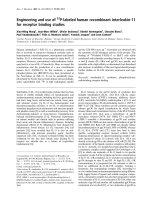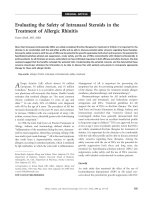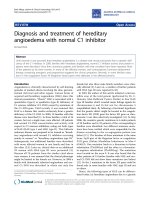Báo cáo y học: "Daptomycin for treatment of methicillin-resistant Staphylococcus epidermidis saphenectomy wound infection after coronary artery bypass graft operation (CABG): a case repor" ppt
Bạn đang xem bản rút gọn của tài liệu. Xem và tải ngay bản đầy đủ của tài liệu tại đây (350.04 KB, 3 trang )
BioMed Central
Page 1 of 3
(page number not for citation purposes)
Journal of Cardiothoracic Surgery
Open Access
Case report
Daptomycin for treatment of methicillin-resistant Staphylococcus
epidermidis saphenectomy wound infection after coronary artery
bypass graft operation (CABG): a case report
Jan D Schmitto*
1,3
, Aron F Popov*
1
, Samuel T Sossalla
2
, Kasim O Coskun
1
,
Suyog A Mokashi
3
, Anton Wintner
3
and Friedrich A Schoendube
1
Address:
1
Department of Thoracic-, Cardiac- and Vascular Surgery, Georg-August-University of Goettingen, Goettingen, Germany,
2
Department of
Cardiology, Georg-August-University of Goettingen, Goettingen, Germany and
3
Division of Cardiac Surgery, Brigham and Women's Hospital,
Harvard Medical School Boston, MA, USA
Email: Jan D Schmitto* - ; Aron F Popov* - ;
Samuel T Sossalla - ; Kasim O Coskun - ; Suyog A Mokashi - ;
Anton Wintner - ; Friedrich A Schoendube -
* Corresponding authors
Abstract
We report a case of successful treatment of postoperative saphenectomy wound infection of the
upper left leg with the antibiotic drug Daptomycin.
Introduction
Since its first clinical use by Rene Favaloro in the 60's, the
great saphenous vein has become the most commonly
harvested conduit for revascularization in coronary artery
bypass grafting (CABG) [1]. In order to reduce morbidity
and improve the recovery time associated with CABG pro-
cedures, various techniques have been developed includ-
ing conventional conduit harvesting, minimally invasive
and/or endoscopic harvesting procedures [2]. Still, these
surgical techniques are associated with significant compli-
cation rates e.g. wound infections, non-infective wound
healing disturbances, postoperative pain, etc. [3]. Avoid-
ing and/or reducing these complication rates is of great
medical and economic interest. Improvements would
result in increased postoperative mobility and quality of
life as well as reduced length of hospital stay following
surgery resulting large cost savings. Although much
research has focused on comparing less invasive and con-
ventional harvest techniques, there is at present no con-
sensus on the areas of postoperative antibiotic drug
treatment of saphenectomy wound infections once an
infection occurs. Further studies are required to compare
treatment methods of saphenectomy wound infections by
different antibiotic drugs. Although, Daptomycin has
already been proven to be effective in the treatment of
bacteremia and endocarditis [4,5] caused by methilin-
resistent Staphylococcus aureus [6,7] and several case
reports about its effectiveness in the field of cardiac sur-
gery exist in the literature [8], there are still no cases
describing the successful treatment of saphenectomy
wound infections by Daptomycin.
Therefore, in this paper we report the first case of success-
ful treatment of a postoperative wound infection after
saphenectomy of the great saphenous vein of the upper
left leg with the new antibiotic drug Daptomycin
(Cubicin
®
, Novartis Pharma Corporation, Germany).
Published: 11 September 2009
Journal of Cardiothoracic Surgery 2009, 4:47 doi:10.1186/1749-8090-4-47
Received: 29 June 2009
Accepted: 11 September 2009
This article is available from: />© 2009 Schmitto et al; licensee BioMed Central Ltd.
This is an Open Access article distributed under the terms of the Creative Commons Attribution License ( />),
which permits unrestricted use, distribution, and reproduction in any medium, provided the original work is properly cited.
Journal of Cardiothoracic Surgery 2009, 4:47 />Page 2 of 3
(page number not for citation purposes)
Case report
We report the case of a 68-year old man with severe, dif-
fuse coronary artery disease who presented with two
months of progressive angina-pectoris-symptoms. Coro-
nary angiography verified 3-vessel-disease with significant
stenoses of the main coronary branches (LAD 99%, RCX
80%, RCA 90%), moderately-decreased systolic left-ven-
tricular function and ST-elevations in leads II, III and aVF.
For these reasons, surgical revascularization was indi-
cated. The patient had a significant history of arterial
hypertension, Type II diabetes mellitus, adipositas, nico-
tine abuse (49 pack years), hypercholersterinemia and
performance of PTCA of the left coronary artery in 2002.
In the Department of Thoracic-, Cardiac- and Vascular
Surgery of the University of Goettingen, Germany, we per-
formed CABG with three single vein-grafts to the diagonal
branch (DB), right posterior descending artery (RPD) and
left posterolateral circumflex artery (LPL). The left anterior
descending artery (LAD) was revascularized by the left
internal mammarian artery (LIMA). Harvest of the saphe-
nous vein was performed by conventional open saphenec-
tomy harvest technique which involved an incision
extending from the left medial malleolus, along the
medial aspect of the knee to the groin.
During the patient's stay in the ICU, hemodynamic condi-
tions were stabilized and the patient was moved to a nor-
mal ward on second postoperative day. On 6
th
postoperative day, after an uneventful mobilization, the
patient was suffering from pain in his leg and he devel-
oped a wound infection of the left upper leg. Saphenc-
tomy wound infection was presented with a large
dehiscence of 5 cm in diameter in the location where the
great saphenous vein had been harvested (Fig. 1). Clinical
laboratory parameters (Leucocytes and CRP) were signifi-
cantly increased and additionally to that, a wound swab
was taken from the infected site and a gram-positive Sta-
phylococcus epidermidis culture was indentified by the
Institute of Microbiology and Hygiene of the University of
Goettingen. The antibiogram presented methilin-resist-
ence as well as resistence to several conventional antibiot-
ics but displayed sensitivity to the new antibiotic drug
Daptomycin (Cubicin
®
, Novartis Pharma Corporation,
Germany). The drug was intravenously administered
(Dose: 4 mg/kg body weight) and total duration of dapto-
mycin-application was ten days. In addition, a VAC
sponge was placed to low continuous wall suction in
order to expedite the secondary wound healing process.
During this time clinical labor parameters decreased sig-
nificantly. Ten days later, another wound swab was taken
from the dehiscent wound but no microbiological culture
was identified. The wound was closed operatively and
healed secondarily without any further complications
(Fig. 2). An additional wound healing benefit was
revealed by application by VAC therapy in combination
with Daptomycin. The patient was discharged from hospi-
tal on the twenty-eighth postoperative day and was sent
for further rehabilitative therapy.
This case describes, to the best of our knowledge, the first
successful treatment of a saphenectomy wound infection
by the new antibiotic drug Daptomycin (Cubicin
®
,
Novartis Pharma Corporation, Germany) (Fig. 3). Further
research is required to evaluate the potential benefits of
this new antibiotic agent. Also, clinical, prospective and
Postoperative wound infection of the left upper limb six days after CABG operation with conventional saphenectomyFigure 1
Postoperative wound infection of the left upper limb
six days after CABG operation with conventional
saphenectomy.
Left upper limb treated with wound infection treated by a combination of vacuum-therapy and Daptomycin (Cubicin
®
, Novartis Pharma GmbH, Germany)Figure 2
Left upper limb treated with wound infection treated
by a combination of vacuum-therapy and Daptomy-
cin (Cubicin
®
, Novartis Pharma GmbH, Germany).
Publish with BioMed Central and every
scientist can read your work free of charge
"BioMed Central will be the most significant development for
disseminating the results of biomedical research in our lifetime."
Sir Paul Nurse, Cancer Research UK
Your research papers will be:
available free of charge to the entire biomedical community
peer reviewed and published immediately upon acceptance
cited in PubMed and archived on PubMed Central
yours — you keep the copyright
Submit your manuscript here:
/>BioMedcentral
Journal of Cardiothoracic Surgery 2009, 4:47 />Page 3 of 3
(page number not for citation purposes)
randomized studies are necessary to compare several
treatment methods for saphenectomy wound infections
using different antibiotic drugs.
Competing interests
The authors declare that they have no competing interests.
Authors' contributions
JDS conceived of the study, and participated in its design
and coordination. AFP conceived of the study, and partic-
ipated in its design and coordination. STS conceived of
the study, and participated in its design and coordination.
KOC participated in the design of the study and per-
formed the statistical analysis. SAM participated in the
design of the study and performed the statistical analysis.
AW participated in the design of the study and performed
the statistical analysis. FAS conceived of the study, and
participated in its design and coordination. Both JDS and
AFP contributed equally to this study. All authors read
and approved the final manuscript.
Consent
Written informed consent was obtained from the patient
for publication of this case report and accompanying
images. A copy of the written consent is available for
review by the Editor-in-Chief of this journal.
Acknowledgements
We gratefully thank Mrs. A. Pencz and Mrs. A. Kiel for technical support of
this study.
References
1. Favaloro RG: Saphenous vein autograft replacement of severe
segmental coronary artery occlusion: operative technique.
Ann Thorac Surg 1968, 5:334-9.
2. Aziz O, Athanasiou T, Darzi A: Minimally invasive conduit har-
vesting: a systematic review. Eur J Cardiothorac Surg 2006,
29(3):324-33.
3. Athanasiou T, Aziz O, Skapinakis P, Perunovic B, Hart J, Crossman
MC, Gorgoulis V, Glenville B, Casula R: Leg wound infection after
coronary artery bypass grafting: a meta-analysis comparing
minimally invasive versus conventional vein harvesting. The
Annals of Thoracic Surgery 2003, 76(6):2141-2146.
4. Fowler VG Jr, Boucher HW, Corey GR, Abrutyn E, Karchmer AW,
Rupp ME, Levine DP, Chambers HF, Tally FP, Vigliani GA, Cabell CH,
Link AS, DeMeyer I, Filler SG, Zervos M, Cook P, Parsonnet J, Bern-
stein JM, Price CS, Forrest GN, Fätkenheuer G, Gareca M, Rehm SJ,
Brodt HR, Tice A, Cosgrove SE: S. aureus Endocarditis and Bac-
teremia Study Group Daptomycin versus standard therapy
for bacteremia and endocarditis caused by Staphylococcus
aureus. N Engl J Med 2006, 355(7):653-6.
5. Furuya EY, Lowy FD: Antimicrobial strategies for the preven-
tion and treatment of cardiovascular infections. Curr Opin
Pharmacol 2003, 3(5):464-9.
6. Marco F, de la Mària CG, Armero Y, Amat E, Soy D, Moreno A, del
Río A, Almela M, Mestres CA, Gatell JM, Jiménez de Anta MT, Miró
JM: Hospital Clinic Experimental Endocarditis Study Group.
Daptomycin is effective in treatment of experimental endo-
carditis due to methicillin-resistant and glycopeptide-inter-
mediate Staphylococcus aureus. Antimicrob Agents Chemother
2008, 52(7):2538-43.
7. Cosgrove SE, Fowler VG Jr: Optimizing therapy for methicillin-
resistant Staphylococcus aureus bacteremia. Semin Respir Crit
Care Med 2007, 28(6):624-31.
8. Weis F, Beiras-Fernandez A, Kaczmarek I, Sodian R, Vicol C, Reichart
B, Weis M: Daptomycin for eradication of a systemic infection
with a methicillin-resistant-Staphylococcus aureus in a biv-
entricular assist device recipient. Ann Thorac Surg 2007,
84(1):269-70.
Left upper limb after successful treatment of the wound infection by Daptomycin (Cubicin
®
, Novartis Pharma GmbH, Germany)Figure 3
Left upper limb after successful treatment of the
wound infection by Daptomycin (Cubicin
®
, Novartis
Pharma GmbH, Germany).









